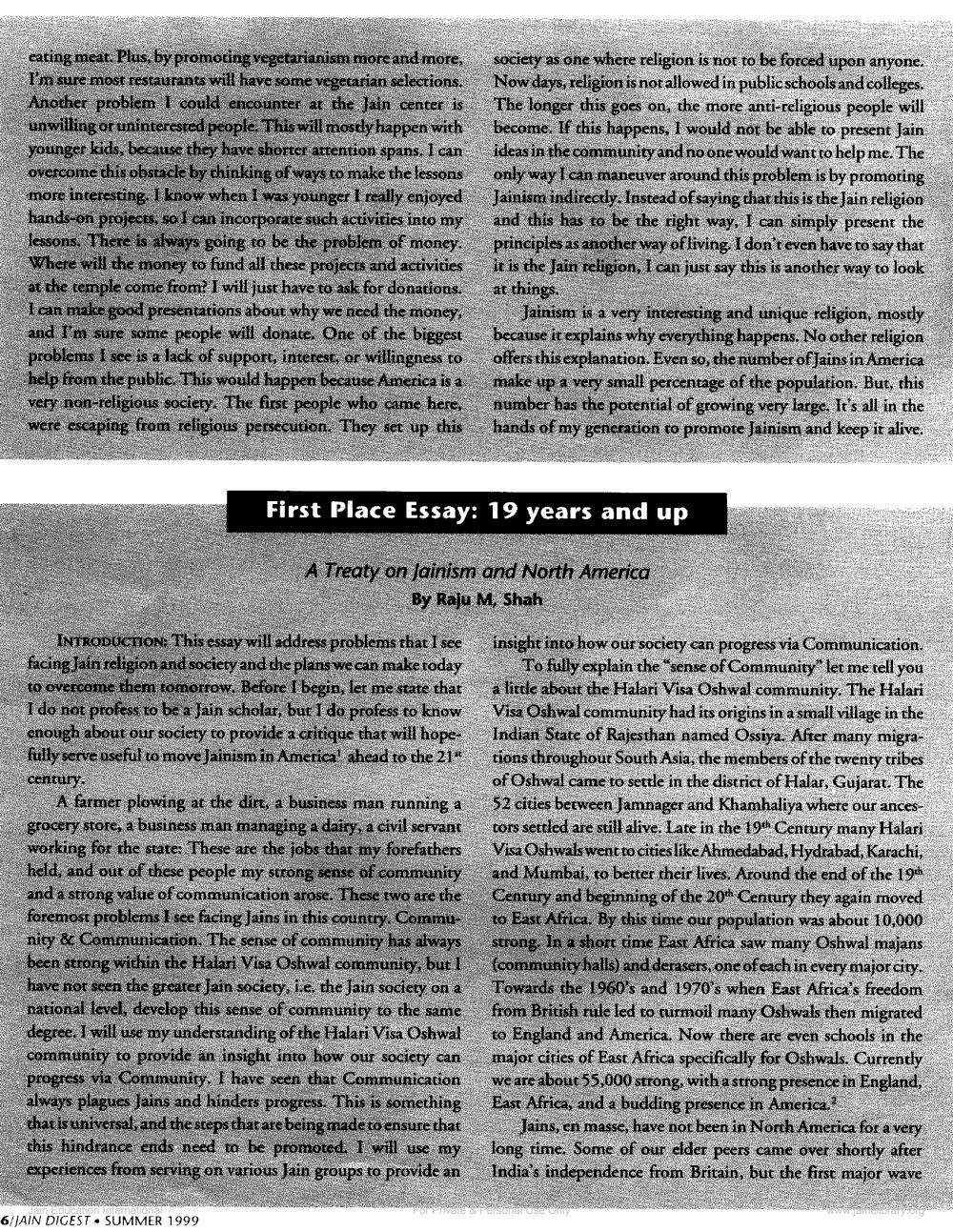________________
eating meat. Plus, by promoting vegetarianism more and more, I'm sure most restaurants will have some vegecarian selections. Another problem I could encounter at the Jain center is unwilling or uninterested people. This will mostly happen with younger kids, because they have shorter attention spans. I can overcome this obstacle by thinking of ways to make the lessons more interesting. I know when I was younger I really enjoyed hands-on projects, so I can incorporate such activities into my lessons. There is always going to be the problem of money. Where will the money to fund all these projects and activities at the temple come from? I will just have to ask for donations I can make good presentations about why we need the money, and I'm sure some people will donate. One of the biggest problems I see is a lack of support, interest, or willingness to help from the public. This would happen because America is a very non-religious society. The first people who came here, were escaping from religious persecution. They set up this
society as one where religion is not to be forced upon anyone. Now days, religion is not allowed in public schools and colleges. The longer this goes on, the more anti-religious people will become. If this happens, I would not be able to present Jain ideas in the community and no one would want to help me. The only way I can maneuver around this problem is by promoting Jainism indirectly. Instead of saying that this is the Jain religion and this has to be the right way, I can simply present the principles as another way of living. I don't even have to say that it is the Jain religion, I can just say this is another way to look at things.
Jainism is a very interesting and unique religion, mostly because it explains why everything happens. No other religion offers this explanation. Even so, the number of Jains in America make up a very small percentage of the population. But, this number has the potential of growing very large. It's all in the hands of my generation to promote Jainism and keep it alive.
NE
First Place Essay: 19 years and up
Treaty on Jainism and North America
By Raju M, Shah
INTRODUCTION: This essay will address problems that I see facing Jain religion and society and the plans we can make today to overcome them tomorrow. Before I begin, let me state that I do not profess to be a Jain scholar, but I do profess to know enough about our society to provide a critique that will hope fully serve useful to move Jainism in America' ahead to the 21* century,
A farmer plowing at the dirt, a business man running a grocery store, a business man managing a dairy, a civil servant working for the state. These are the jobs that my forefathers held, and out of these people my strong sense of community and a strong value of communication arose. These two are the foremost problems I see facing Jains in this country. Commu-
nity & Communication. The sense of community has always e been strong within the Halari Visa Oshwal communicy, but I have not seen the greater Jain society, i.e. the Jain society on a national level, develop this sense of community to the same degree. I will use my understanding of the Halari Visa Oshwal community to provide an insight into how our society can progress via Community. I have seen that Communication always plagues Jains and hinders progress. This is something that is universal, and the steps that are being made to ensure that this hindrance ends need to be promoted. I will use my experiences from serving on various Jain groups to provide an
insight into how our society can progress via Communication.
To fully explain the “sense of Community" let me tell you a little about the Halari Visa Oshwal community. The Halari Visa Oshwal community had its origins in a small village in the Indian State of Rajesthan named Ossiya. After many migrations throughout South Asia, the members of the twenty tribes of Oshwal came to settle in the district of Halar, Gujarat. The 52 cities between Jamnager and Khamhaliya where our ancestors settled are still alive. Late in the 19th Century many Halari Visa Oshwals went to cities like Ahmedabad, Hydrabad, Karachi, and Mumbai, to better their lives. Around the end of the 19ch Century and beginning of the 20th Century they again moved to East Africa. By this time our population was about 10,000 strong. In a short time East Africa saw many Oshwal majans (community halls) and derasers, one of each in every major city. Towards the 1960's and 1970's when East Africa's freedom from British rule led to curmoil many Oshwals then migrated to England and America. Now there are even schools in the major cities of East Africa specifically for Oshwals. Currently we are about 55,000 strong, with a strong presence in England, East Africa, and a budding presence in America.?
Jains, en masse, have not been in North America for a very long time. Some of our elder peers came over shortly after India's independence from Britain, but the first major wave
6/JAIN DIGEST SUMMER 1999




